INTRODUCTION
It is well known that endodontic treatment is a series of surgical steps aiming primarily at root canal system disinfection. Purely from a didactic point of view, the dental academia divided the endodontic technique into separate steps or phases so that the student could understand and practice systematically; from a clinical standpoint, the process is quite different. Endodontic treatment consists of interdependent procedures focused on neutralizing the etiologic agent that causes inflammatory apical periodontal disease. The primary goal is to help the patient’s defense system curb the inflammation, restore balance, and promote tissue repair.
In a series of papers previously published in Dentistry Today, I discussed instrumentation separately from irrigation. This is a didactic concept that often ends up giving the impression that mechanical instrumentation and chemical irrigation are different techniques. Cleaning and shaping should be seen as one single procedure. Mechanical instrumentation opens the way for the action of chemical disinfection by using irrigating solutions and intracanal medicaments. Therefore, this paper will consider the 2 procedures as a single process, unifying instrumentation and irrigation as a symbiotic step for the success of the overall treatment. Finding the Foramen Exit Anatomy plays a decisive role in facilitating or debilitating finding and securing the foraminal exit. By applying well-known technologies with new purposes, we are creating solutions based on researched and evidence-based results. Piezoelectric ultrasonic transducers are not a recent development, but their use in endodontics for the last 45 years has led to the appearance of new insert designs with different applications. Examples include 2 recently launched inserts developed to facilitate the identification of root canal entrances sometimes hidden by complex anatomy configurations.
Trumpet and Scout Ultrasonic Tips:
After the access cavity is done by using high and low-speed burs, the first tip to be used is the Sonus ED27 Trumpet (Medidenta). This inverted cone 0.70-mm tip is used to remove dentin wall projections over the canal entrances, especially at the upper molar MB2 opening. With lateral action, this tip should be used to touch the pulp chamber floor and as a guide toward the axial pulp chamber wall. The inverted cone shape gives the right angle to follow the minimal space between the pulp chamber floor and lateral wall projection. The ultrasonic vibration transferred to the insert tip gently removes the dentin projection, releasing the canal entrance orifice.
The Scout ED28 (Medidenta) is the second insert to be used. This delicate tip works like an explorer with a 0.25-mm tip diameter tip and a .035 taper, defining the canal orifice and gently enlarging it with ultrasonic vibration. It can subsequently be used to clean the cervical isthmus areas (Figure 1).
Before Anything Else, Remove the Bulk Canal Content Using the Sonicstream Method:
The classic initial approach for root canal disinfection is commonly performed by mechanical instrumentation, which removes the large bulk of the pulp tissue, the necrotic debris, and bacterial biofilms. The most common movements used to activate the rotary/reciprocation file inside the canal are pecking or brushing. However, when inserting the instrument into the canal, the operator risks pushing necrotic content to the apical third or even farther. Knowing that the vast majority of the infectious bacterial contingent is found in the cervical and middle thirds, this procedure could potentially extrude bacteria and endotoxins to the apical tissue, especially in cases where the apical foramen is partially eroded.
Rather than performing the first intracanal intervention with mechanical instruments, it would be reasonable to wash the first two thirds of the canal to reduce the bacterial contingent and its endotoxins without risking extrusion and postoperative pain.
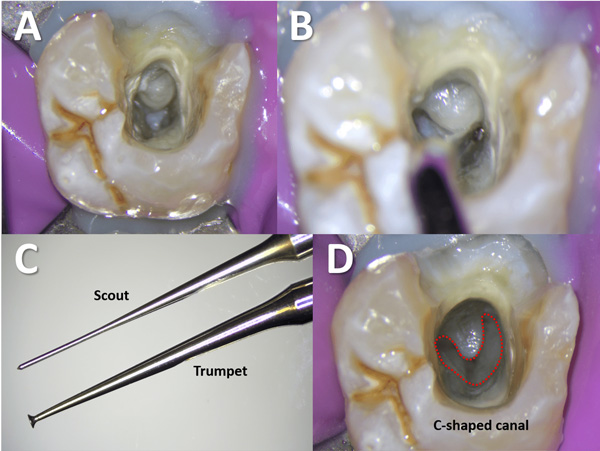 |
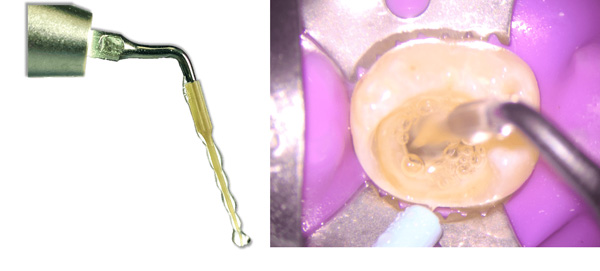 |
| Figure 1 (a) Second upper molar showing a calcification inside the pulp chamber. (b) Trumpet tip in action. (c) Sonus Scout and Trumpet piezoelectric ultrasonic tips (Medidenta). (d) A C-shaped canal after Trumpet action. | Figure 2 (a) The ED70 connector (Medidenta) with the disposable Polysonic ED71 polymer tip (Medidenta) with continuous irrigation flow. (b) The Polysonic in action. |
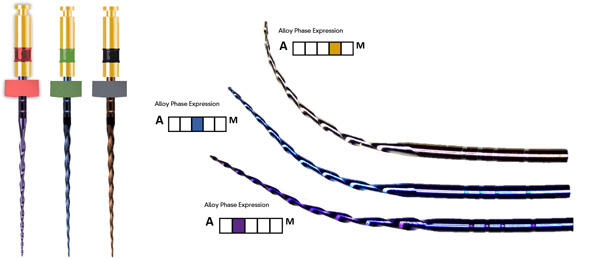 |
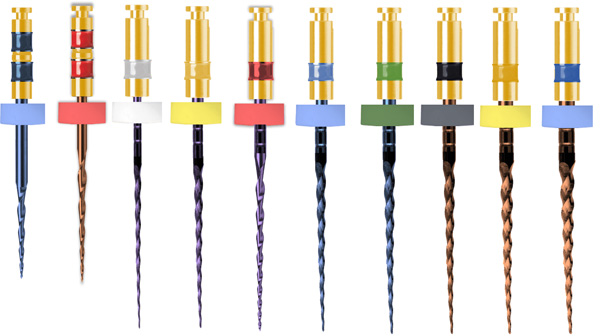 |
| Figure 3 Three examples of Genius Proflex files (Medidenta) with different tailored heat treatments: more austenic (A) phase expression for the purple heat treatment, a balanced austenic-martensic phase expression for the blue heat treatment, and more martensic (M) phase expression for the gold heat treatment. | Figure 4 Figure 4. Genius Proflex full sequence. From left to right: Orifice Shaper 30 .08, Curvature Sweetener 25 .06, Pathfinder 13 .03, Pathfinder 17 .05, 25 .04, 30 .04, 35 .04, 40 .04, 50 .04, and 60 .04. The colors of the blades correspond to different customized heat treatments. |
A new irrigation procedure using a high-performance thermoplastic polymer (polyether ether ketone [PEEK]) ultrasonic tip with small dimensions brings some advantages over conventional syringe/cannula irrigation. The SonicStream method is a constant flow, microstreaming irrigation based on the E71/E72 high-performance thermoplastic PEEK Polysonic tip (Medidenta) activation (Figure 2). The ultrasonic activation of irrigation fluids creates acoustic microstreaming and transient cavitation that pushes the liquid laterally into the irregularities of the canal.1 Acoustic microstreaming is defined as a rapid movement of fluid in a vortex motion, generating shear stresses that enhance debridement. Transient cavitation generates bubbles that, when collapsing, produce radiating shock waves and an increase in temperature. The continuous irrigant flow is achieved by simultaneously and continuously delivering irrigation liquid during ultrasonic activation without apical forces2 through the specially designed 0.28-mm-diameter tip and .04 taper Polysonic polymer tip. This is in contrast to conventional intermittent ultrasonic activation, which needs manual (syringe and cannula) replacement of the liquid inside the canal.
When applying the SonicStream technique initially in the first two thirds (or even up to the temporary working length), effective cleaning of this area will be achieved without the use of mechanical instruments, allowing the removal of a large contingent of septic material and preparing a clean space for the following steps (Figure 2).
The New Customized Heat-Treated Genius Proflex Files:
Heat treatment is used to obtain maximum efficiency of the material under the demanding conditions of service. It can be defined as a combination of heating and cooling procedures timed and applied to an alloy in the solid state to create the desired properties. The methods of swordsmiths’ and cutlers’ trades make the process of hardening steel clear by plunging the red-hot solid steel into the water, toughening it, and then tempering the quench-hardened steel at a moderate temperature.
In endodontics, the heat-treatment process for NiTi files is used to fulfill some specific properties, such as flexibility, and to get higher scores in terms of cyclic fatigue resistance. The number of cycles of rotation in a curve canal can be enhanced by the proper treatment of the file. Another interesting property achieved with heat treatment is the capacity to pre-bend a NiTi file. Control of the transformation temperatures of the NiTi alloy, which can be achieved by heat treatment, is one of the most important tools for manufacturers to alter the phase composition and, consequently, the mechanical properties of the NiTi alloy. NiTi raw wires are provided by manufacturers in a cold-worked state.3 Heat treatment of the cold-worked NiTi alloy in a temperature range around 450° to 550°C allows it to release internal stresses and reduces the defects of the crystal lattice by giving the atoms enough thermal energy to rearrange themselves. Consequently, heat-treated NiTi alloy has significantly increased cyclic fatigue resistance and higher transformation temperatures than non-heat-treated NiTi alloys.4
It is well known that different file diameters show different flexibilities. As a rule, small diameters show more flexibility than bigger diameters. It is also known that small diameters are more prompt to torsional fatigue, and the opposite happens with large diameters. Therefore, different heat-treatment recipes should be applied to increase torsional resistance for smaller file sizes and increase cyclic fatigue resistance for large-diameter files. The recently launched Genius Proflex files (Medidenta) are made with different customized heat treatments for each group of instruments, balancing flexibility and resistance to the metal mass of each instrument in the series (Figure 3). Two different cross sections are used—triangular rhomboidal and double S—ensuring once again that each instrument is suited perfectly to an aspect of the instrumentation phase, whether it is glidepath preparation, enlargement, or even final apical shaping. The file series has options for preflaring, mechanical glide paths, and shaping with 3 distinct heat-treatment recipes discernible by the color of the blade: purple for a more austenitic performance, blue for a perfectly balanced austenitic-martensitic performance, and gold for a super-flexible martensitic predominant phase file5 (Figure 4).
Curvature Sweetener:
The 19-mm, 25 .06 gold heat-treated file is called the “Curvature Sweetener.” Unlike the usual super-tapered orifice shapers, the Curvature Sweetener is designed to work up to the middle of the curvature (Figure 5). It is possible because of the extreme flexibility of this heat-treated, controlled memory file. The Curvature Sweetener will remove the most difficult interferences at the curvature space, allowing the next file in the sequence to work solely at the last millimeters of the canal.
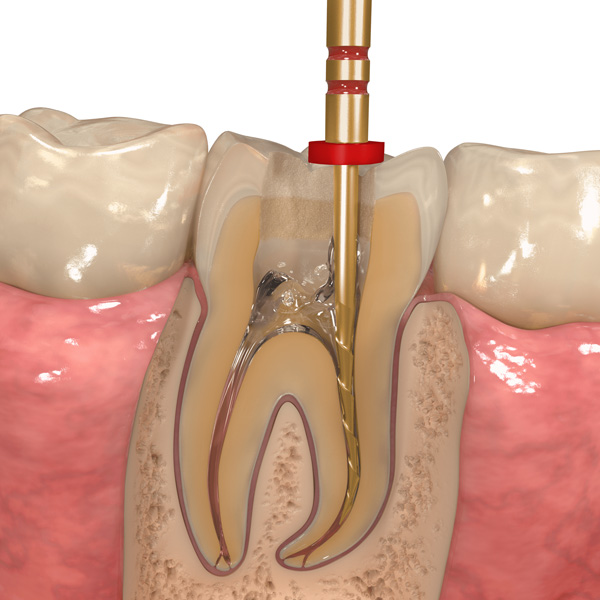 |
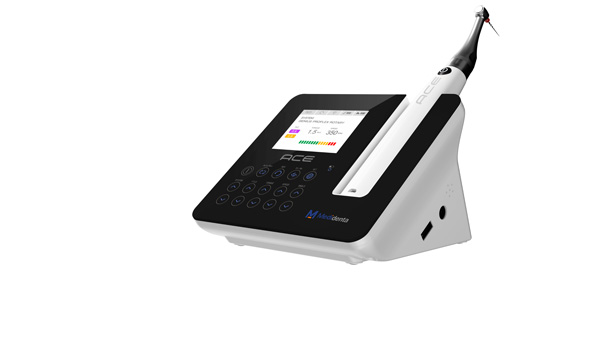 |
| Figure 5 The Genius Proflex “Curvature Sweetener” gold heat treatment working at the middle of the curvature. | Figure 6 The ED70 connector with the disposable Polysonic high-performance PEEK irrigation tip. |
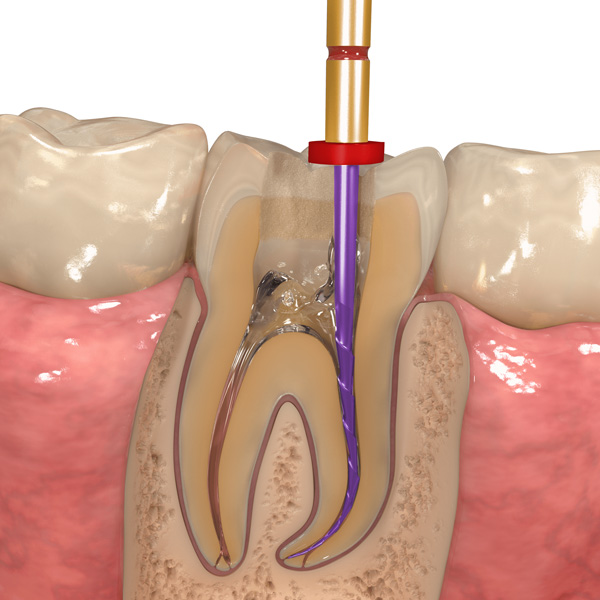 |
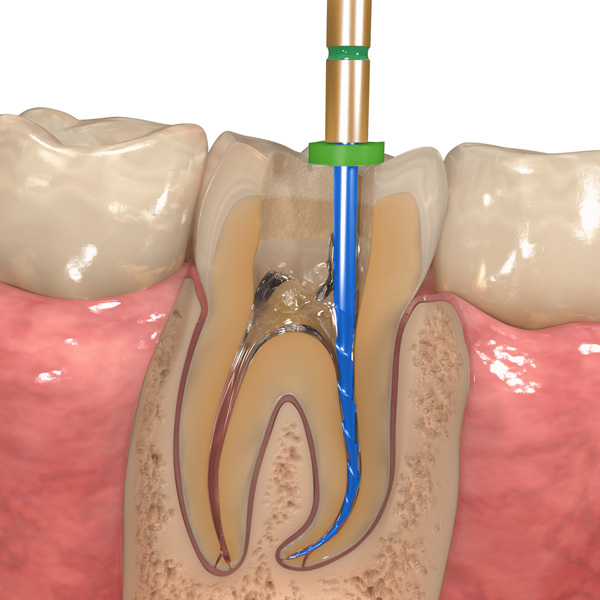 |
| Figure 7 Sonus piezoelectric unit (Medidenta). | Figure 8 Advanced Cordless Endomotor (ACE) (Medidenta). |
Genius AutoSense With the ACE Endomotor:
Until 2015, clinicians had to use 2 different file systems to engage in reciprocation and rotation. They would start with left-cutting reciprocation from the single-file system, change the file for a rotary file system, and then try to match size and taper to the proper rotary file in the sequence. It is very difficult to perfectly match a single-file-technique instrument with a rotary file. Therefore, the safety benefits generated by the reciprocation movement end up being left aside when the operator is required to use the rotary movement with a larger-sized instrument that would generate some degree of enlargement.
In 2015, a new open endodontic motor concept and a set of NiTi files designed to be able to achieve the highest performance in both reciprocation and rotation (Genius motor [Medidenta]) were introduced to the market. The Genius system allowed the clinician to begin with a 25 .04 file in right-cutting asymmetric reciprocation and finish with the same file in rotation to optimize debris removal.6
Improvements were made to both the motor and Genius files. The Advanced Cordless Endomotor (ACE) (Medidenta) has more features than the original Genius motor and a built-in apex locator. The cordless open motor kinematics can be changed from rotary to reciprocation in different angles in 10° increments and present a new unique program called Genius Autosense. This feature automatically changes the movement from rotary to right-cutting reciprocation based on the measurement of the canal walls’ resistance against the file’s apical progress. The operator can control the rotary or reciprocation movement automatically by apically moving the file. The motor settings can also determine the sensitivity of this movement. The new Genius Proflex files are more flexible due to the aforementioned customized heat/size treatment. In addition to the original file sequence, Genius Proflex presents 2 glidepath files (13 .03 and 17 .05), the described Curvature Sweetener, and a 60 .04 heat-treated file.
SonicStream During Instrumentation and Final Irrigation: Mechanical instrumentation is performed by using either stainless steel hand files or engine-driven NiTi rotary and/or reciprocation files. Neither of these is expected to completely clean the canal when used alone but will instead create a “space” that will be filled by irrigation liquid to provide the desired cleaning effect. A substantial part of the root canal wall is left untouched by contemporary instrumentation techniques, and irrigation may be considered the primary method to clean and disinfect these areas of the root canal system.7
Using ultrasonic-assisted irrigation, the solution can access areas that were not touched by the instruments and are hardly ever reached when used in other modes due to the high surface tension of the irrigant. It has also been reported to allow better penetration into lateral canals and narrow isthmuses compared to syringe and cannula irrigation. The cavitation effect, combined with the increase in NaOCl temperature, has also resulted in better tissue dissolution.8,9
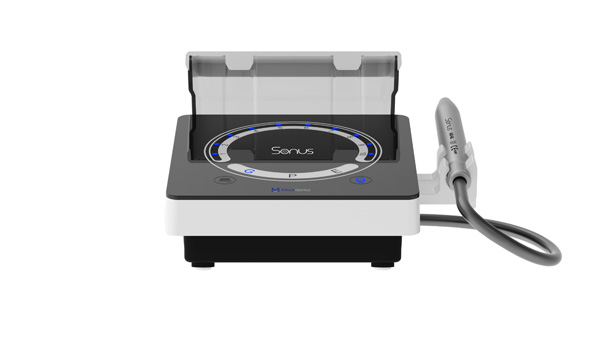 |
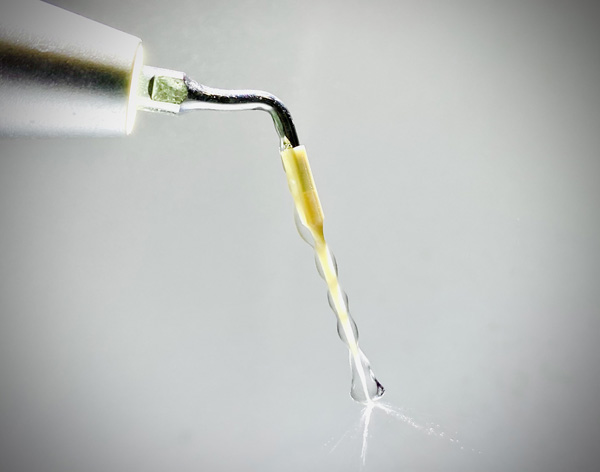 |
| Figure 9 Genius Proflex 25 .04 file with purple heat treatment. | Figure 10 Genius Proflex 35 .04 with blue heat treatment. |
SonicStream constant flow microstreaming irrigation consists of a high-performance thermoplastic PEEK insert (Polysonic [Medidenta]) (Figure 6) with a 0.28-mm tip diameter and a .035 taper. In this type of delivery/activation method, the liquid comes directly from a reservoir to an exit port located at the Sonus LED Piezoelectric (Figure 7) ED70 ultrasonic connector. The liquid passively navigates the surface path of the tip to its end without apical pressure. This allows the operator to insert and activate the liquid without apical pressure, preventing apical extrusion of the irrigant.
By continuously using a new reactant (NaOCl or EDTA), the chemical reaction will always be in favor of tissue dissolution, keeping a high concentration of chlorine (in the case of NaOCl) and chelating action (in the case of EDTA) in the canal. Furthermore, the high-performance polymer used in the Polysonic tip allows it to negotiate curvatures without ledging.
Genius Proflex and SonicStream Technique Description:
1. Scout the canal with an SS K-File No. 10 or 15.
2. Set the ACE motor to Genius Autosense operation mode.
3. Proceed with a measurement of the canal at the radiographic image to determine the Curvature Sweetener WL. Use the Curvature Sweetener 25 .06 up to the middle of the curvature (Figure 5).
4. Determine the cleaning and shaping WLs using apex locator mode on the ACE endomotor (Figure 8).
5. Use the Genius Proflex 25 .04 file to WL (Figure 9) in a crown-down approach by performing brushing movements. Use pecking movements to activate the reciprocation motion automatically to safely get space to the WL.
6. Achieving patency with a hand K-File (the same one used during the electronic measurement).
7. Finish with the final 35 .04 Genius Proflex file (Figure 10) or a larger one, depending on the anatomy of the canal.
8. Perform all instrumentation with irrigant/lubricant inside the canal. After 10 seconds of instrumentation, or at each instrument exchange, use copious irrigation with SonicStream constant flow microstreaming ultrasonic irrigation (Sonus [Figure 7] and Polysonic [Figure 6]).
CLOSING COMMENTS
There are significant advantages to the correct use of customized heat-treated files during the engine-driven instrumentation of the root canal system. The hybrid use of right-cutting reciprocating and rotary motions provides evidence-based10-12 safety and efficiency for the instrumentation phase, significantly reducing the chance of instrument fracture13 and improving canal shaping. It is also important to emphasize that the cleaning effect will only be achieved by simultaneously using mechanical instrumentation and ultrasonically activated constant flow irrigation.14,15F
REFERENCES
1. Macedo RG, Verhaagen B, Wesselink PR, et al. Influence of refreshment/activation cycles and temperature rise on the reaction rate of sodium hypochlorite with bovine dentine during ultrasonic activated irrigation. Int Endod J. 2014;47(2):147–54. doi:10.1111/iej.12125
2. Robinson JP, Macedo RG, Verhaagen B, et al. Cleaning lateral morphological features of the root canal: the role of streaming and cavitation. Int Endod J. 2018;51 Suppl 1:e55-e64. doi:10.1111/iej.12804
3. Shen Y, Zhou HM, Zheng YF, et al. Current challenges and concepts of the thermomechanical treatment of nickel-titanium instruments. J Endod. 2013;39(2):163–72. doi:10.1016/j.joen.2012.11.005
4. Zhou HM, Shen Y, Zheng W, et al. Mechanical properties of controlled memory and superelastic nickel-titanium wires used in the manufacture of rotary endodontic instruments. J Endod. 2012;38(11):1535–40. doi:10.1016/j.joen.2012.07.006
5. Shabalovskaya S, Anderegg J, Van Humbeeck J. Critical overview of Nitinol surfaces and their modifications for medical applications. Acta Biomater. 2008;4(3):447–67. doi:10.1016/j.actbio.2008.01.013
6. Drukteinis S, Peciuliene V, Dummer PMH, et al. Shaping ability of BioRace, ProTaper NEXT and Genius nickel-titanium instruments in curved canals of mandibular molars: a MicroCT study. Int Endod J. 2019 Jan;52(1):86-93. doi:10.1111/iej.12961
7. Siqueira JF Jr, Araújo MC, Garcia PF, et al. Histological evaluation of the effectiveness of five instrumentation techniques for cleaning the apical third of root canals. J Endod. 1997;23(8):499-502. doi:10.1016/S0099-2399(97)80309-3
8. Ahmad M, Pitt Ford TR, Crum LA. Ultrasonic debridement of root canals: an insight into the mechanisms involved. J Endod. 1987;13(3):93-101. doi:10.1016/S0099-2399(87)80173-5
9. Susin L, Liu Y, Yoon JC, et al. Canal and isthmus debridement efficacies of two irrigant agitation techniques in a closed system. Int Endod J. 2010;43(12):1077–90. doi:10.1111/j.1365-2591.2010.01778.x
10. Bueno CRE, Cury MTS, Vasques AMV, et al. Cyclic fatigue resistance of novel Genius and Edgefile nickel-titanium reciprocating instruments. Braz Oral Res. 2019;33:e028. doi:10.1590/1807-3107bor-2019.vol33.0028
11. Gundogar M, Sezgin GP. Cyclic fatigue resistance of Genius, RC gold and Revo-S nickel-titanium Instruments. IJADS. 2018;4:342-345. doi:10.22271/oral.2018.v4.i4f.520
12. Cavalli D, Toia CC, Flores Orozco EI, et al. Effectiveness in the removal of endotoxins and microbiological profile in primary endodontic infections using 3 different instrumentation systems: a randomized clinical study. J Endod. 2017;43(8):1237-1245. doi:10.1016/j.joen.2017.03.032
13. Drukteinis S, Peciuliene V, Bendinskaite R, et al. Shaping and centering ability, cyclic fatigue resistance and fractographic analysis of three thermally treated NiTi endodontic instrument systems. Materials (Basel). 2020;13(24):5823. doi:10.3390/ma13245823
14. Layton G, Wu WI, Selvaganapathy PR, et al. Fluid dynamics and biofilm removal generated by syringe-delivered and 2 ultrasonic-assisted irrigation methods: a novel experimental approach. J Endod. 2015;41(6):884–9. doi:10.1016/j.joen.2015.01.027
15. Plotino G, Colangeli M, Özyürek T, et al. Evaluation of smear layer and debris removal by stepwise intraoperative activation (SIA) of sodium hypochlorite. Clin Oral Investig. 2021;25(1):237-245. doi:10.1007/s00784-020-03358-6
ABOUT THE AUTHOR
Dr. Ramos graduated with a degree in dentistry from the State University of Londrina in Brazil (1987). He has a PhD in endodontics and is a former head of the endodontics department at the State University of Londrina. He has had 3 endodontic textbooks published and has written more than a dozen chapters for various endodontic books. Living in the United States since 2012, Dr. Ramos lectures globally about streamlined endodontic protocols. He lives in Las Vegas with his family. He can be reached at carlos.ramos@medidenta.com.
Disclosure: Dr. Ramos is the clinical affairs director for Medidenta.










